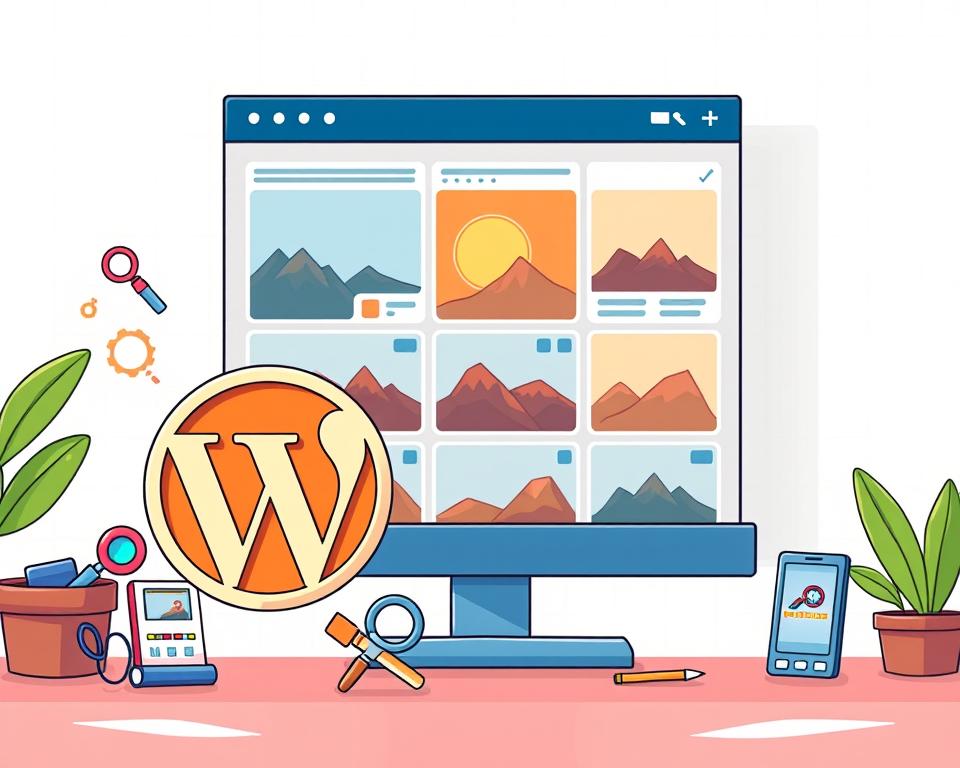Dominate SEO with WordPress: Quick Handbook
Interestingly, 78% of companies built on WordPress see improved search-engine rankings after deploying targeted SEO tactics. WordPress SEO tuning has evolved into a crucial component for digital triumph. It transforms websites from hidden to irresistible for search engines.
WordPress offers a powerful platform for website owners striving to increase their online visibility. With built-in functions and flexible optimization tools, WordPress SEO services can assist businesses climb SERPs efficiently. SEO Marketing Nerds recommend leveraging these built-in capacities to build a robust digital profile.
Our guide will lead you through the top SEO on WordPress, showcasing expert tactics that transform your website into a ranking magnet. If you’re a professional SEO consultant or a site owner, these strategies will let you unlock your website’s full potential using best WordPress SEO.
From understanding basic optimization techniques to deploying advanced strategies, this guide delivers ready-to-use advice to boost your WordPress website’s search outcomes. Prepare to delve into the realm of WordPress SEO and watch your web exposure rise.
Mastering WordPress SEO Essentials
WordPress and SEO are in natural alignment, boosting your site’s visibility in search results. As a robust content management system, WordPress offers a steady foundation for SEO efforts.
Grasping WordPress SEO essentials can radically change your site’s digital footprint. It offers distinct perks for SEO professionals and site owners alike:
- Clean HTML code structure
- Mobile-responsive layouts
- User-friendly content editing
- Comprehensive plugin library for SEO improvements
Choosing WordPress.org over WordPress.com grants you full control for SEO fine-tuning. The independent version enables for deeper customization, crucial for in-depth SEO methods.
WordPress’s SEO advantages are numerous:
- Flexible permalink structures
- Fast content deployment
- Simple metadata handling
- Built-in features for search-engine visibility
To boost SEO on a WordPress site, it’s vital to know these fundamental components. Winning WordPress SEO demands a strategic blend of technical optimization and top-quality content.
Expert tip: A WordPress SEO specialist always puts first user experience alongside search-engine needs.
Must-Have WordPress SEO Tweaks
Setting up the right SEO settings is essential for any WordPress site. A well-configured WordPress SEO setup can greatly boost your site’s search-engine success and visibility. Professional WordPress SEO firms advise a methodical approach to these key settings.

Here are the core settings that make your WordPress site SEO-friendly:
- Configure Permalink Structure
- Use clean, meaningful URL formats
- Include targeted keywords in permalinks
- Avoid long, complex URL strings
- Create XML Site Map
- Provide a complete sitemap
- Upload to Google Search Console
- Confirm all key pages are discovered
- Install SSL Certificate
- Switch to HTTPS for stronger security
- Enhance WordPress Google SEO ranking signals
- Protect user data
A WordPress SEO pro plugin can streamline these settings. During your WordPress SEO review, prioritize maintaining a clean foundation that search engines will favor. Emphasize clean site architecture, fast loading speeds, and intuitive content hierarchies.
Pro Tip: Regular optimization is essential to sustaining solid search-engine performance.
Keep in mind, these WordPress SEO-friendly settings are your starting point toward improved digital exposure and search rankings.
Practical SEO Usage for WordPress
To boost your WordPress site’s exposure, a well-planned approach is vital. Knowing how to apply SEO to WordPress can greatly improve your web footprint and pull in more targeted traffic.
Many strategies can raise your site’s search-engine positions. These include:
- Craft title tags and meta descriptions
- Produce high-quality content
- Leverage WordPress local SEO techniques
- Build solid internal linking structures
- Improve image optimization
WordPress SEO best practices emphasize several key areas. Content quality remains the top factor in search-engine rankings. Your website should offer unique information that meets user needs.
For brick-and-mortar companies, focusing on geographic-specific keywords is vital. This includes using location-based terms and producing content that speaks with your local audience.
Effective SEO is about crafting a frictionless user experience while signaling authority to search engines.
Back-end optimization is a key component of your WordPress SEO strategy. Ensure your website loads quickly, is mobile-friendly, and has a logical, logical structure. This helps for search engines to crawl your site.
Finding the Perfect WordPress SEO Tool
Selecting the right SEO plugin can significantly enhance your WordPress website’s search success. Whether you’re a beginner or an advanced SEO practitioner, you require robust tools to tune your site efficiently.
When reviewing WordPress SEO plugins, look at these critical factors:
- Intuitive interface for WordPress on-page SEO
- Wide-ranging optimization features
- Live content analysis capabilities
- XML sitemap creation
- Schema markup support
Leading WordPress SEO plugins to try include:
- Yoast SEO: Feature-rich content optimization tool
- All in One SEO Pack: Wide feature set
- Rank Math: Flexible configuration options
A WordPress SEO consultancy typically suggests plugins that ease technical optimization while offering detailed site analysis. Key considerations include ease of use, performance impact, and alignment with your specific SEO website WordPress targets.
Expert insight: Always trial plugins in a development environment before production implementation.
Select a plugin that matches your comfort zone and offers actionable guidance for boosting your site’s search-engine visibility.
WordPress On-Page SEO Methods
Perfecting on-page SEO is vital for WordPress sites looking for higher search-engine results. Basic SEO WordPress tactics can significantly increase your content’s visibility. This, in turn, pulls in more search traffic to your site.
Core optimization techniques include:
- Writing persuasive title tags with primary keywords
- Writing descriptive meta descriptions
- Arranging content with strategic header tags
- Using keyword-rich URLs
When using WordPress SEO support, it’s essential to create descriptive title tags. Keep them between 50-60 characters long. Put your primary keyword at the start and include your brand name at the conclusion. These strategies assist search engines grasp your content’s context.
For best results, work on polishing your content layout. Use h1 tags for main titles, h2 for section headings, and H3 for subsections. This hierarchical approach improves both readability and SEO performance.
URL optimization is another key aspect of SEO optimization WordPress. Ensure your URLs are short, meaningful, and contain targeted keywords. Steer clear of complicated structures that can confuse users and search engines equally.
Keep in mind: On-page SEO is about creating high-value, clear content that serves both users and search algorithms.
Content Strategies for WordPress SEO
Developing effective content is the foundation of WordPress search optimization. An effective WordPress SEO optimization service demands a strategic content approach that attracts both search engines and readers.
Using WordPress long-tail keyword tactics includes several vital steps:
- Conduct thorough keyword research to find relevant search terms
- Develop content that specifically addresses user questions
- Provide original, insightful insights not found elsewhere
- Arrange content for readability
When improving SEO on WordPress, prioritize crafting high-quality content that delivers true value. Quality trumps quantity every time. Use long-tail keywords naturally within your text, ensuring they fit seamlessly with the content.
To improve SEO WordPress performance, adopt these content strategies:
- Publish detailed articles
- Consistently update existing content
- Incorporate internal linking to tie together related posts
- Keep a regular publishing schedule
Strong content is the connection between your website and your audience’s needs.
By applying these WordPress search optimization techniques, you’ll create engaging content that not only shows up high but also provides meaningful value to your visitors.
Technical SEO Implementation
Technical SEO is the backbone of a robust WordPress site optimization roadmap. The proper technical elements can dramatically boost your website’s search-engine results and user experience.
When setting up SEO for WordPress, several critical technical factors need attention. Site speed is a fundamental ranking factor that directly impacts search visibility. Google’s Core Web Vitals now assess websites based on loading performance, interactivity, and visual stability.
- Improve site speed through caching mechanisms
- Minimize HTTP requests
- Optimize and scale images
- Take advantage of browser caching
For WordPress site SEO optimization, consider adding structured data and schema markup. These technical elements enable search engines get your content with greater accuracy. This can potentially enhance rich snippet displays in search results.
Mobile optimization is another vital technical SEO component. With mobile-first indexing, making sure your WordPress website performs flawlessly across devices is crucial. Responsive design and speedy mobile performance are a must-have for high rankings.
Expert note: Use advanced SEO WordPress plugins to simplify technical optimization tasks.
By utilizing these technical SEO strategies, you’ll create a robust foundation for better search-engine visibility and user engagement on your WordPress website.
SEO-Focused Image Tactics
Visual content is vital for WordPress sites. Compressing images for SEO can greatly enhance your site’s performance and search results. Properly compressed and tagged images boost user experience and SEO.
Strong image optimization entails several important strategies:
- Compress images to reduce file sizes without losing quality
- Use descriptive file names with relevant keywords
- Add keyword-based alt text for search-engine understanding
- Use lazy loading to improve page load times
When optimizing your WordPress site for SEO, consider these image optimization techniques:
- Select the right file format (JPEG for photographs, PNG for graphics)
- Adjust images before uploading
- Use WordPress SEO plugins like Yoast or EWWW Image Optimizer
“Images are not just visual elements; they’re valuable SEO tools when used intentionally.” — Digital Marketing Expert
Adding WordPress SEO internal links and WordPress SEO links within image captions can further improve your website’s search visibility. Keep in mind, well-optimized images result in quicker load times and higher user engagement.
Internal Linking and Site Structure
Internal linking is a vital element in technical SEO for WordPress, noticeably enhancing your site’s search-engine results. It helps search engines comprehend your site’s layout and distributes page authority across pages. This is crucial for better search-engine performance.
When tuning your WordPress site for search engines, keep in mind these critical internal linking tactics:
- Create a logical site hierarchy for easy navigation
- Use descriptive anchor text for context
- Link to related content on your WordPress homepage
- Prioritize connecting with your money pages
For effective SEO on your WordPress site, create contextual links. This involves adding links where they add real value to readers. Thoughtful internal linking greatly benefits WordPress on-page SEO, helping search engines in understanding your site’s content structure.
Pro Tip: Think of internal links as a roadmap that directs both users and search engines through your website’s information architecture.
By adopting a strategic internal linking approach, you’ll improve user experience, improve site navigation, and lift your WordPress site’s search-engine exposure.
Speeding Up WordPress
Site speed is a key factor in WordPress SEO performance. Search engines, like Google, prioritize websites that display quickly. This renders speed optimization critical for better search rankings and a superior user experience.
To boost your WordPress site’s speed, start by measuring its current performance with tools like Google PageSpeed Insights. This tool highlights areas for optimization in loading times.
- Install caching plugins for WordPress SEO optimization
- Deploy a Content Delivery Network (CDN)
- Cut HTTP requests
- Shrink images and media files
Yoast SEO WordPress users can get extra speed optimization features. Reducing server response times and decluttering your WordPress database are important for faster site performance.
Important WordPress SEO tips for speed include:
- Pick lean themes
- Delete unnecessary plugins
- Enable browser caching
- Optimize and tune images
By using these SEO on-page WordPress strategies, you’ll build a speedier, streamlined website. This will allow it to rank better in search results.
Mobile SEO for WordPress
In today’s digital world, mobile optimization is key for WordPress sites. Google now indexes mobile versions first, affecting your site’s search results. A WordPress SEO course must highlight responsive design for a consistent user experience on all devices.
For mobile-friendly WordPress sites, consider these SEO optimization WordPress strategies:
- Choose a responsive WordPress theme that adjusts to different screen sizes
- Boost page loading speed for mobile devices
- Make sure readable text without zooming
- Create touch-friendly navigation elements
When optimizing for WordPress, evaluate your site’s mobile performance with Google’s Mobile-Friendly Test. WordPress SEO optimizer plugins can rapidly identify and fix mobile issues.
Key mobile optimization techniques consist of:
- Optimize images for faster mobile loading
- Use responsive design frameworks
- Use AMP (Accelerated Mobile Pages)
- Optimize SEO title WordPress for mobile search results
By aiming at mobile optimization, you improve user experience and improve search rankings. Search engines give priority to sites with great mobile performance, raising your visibility in search results.
Wrapping It Up
Excelling at the most effective SEO WordPress methods needs dedication and a commitment to ongoing learning. The techniques we’ve covered offer a strong foundation for boosting your website’s search-engine visibility. From selecting the ideal SEO plugins to implementing technical optimizations, you now have a comprehensive set of tools to enhance your site’s performance.
SEO with WordPress is a continuous journey of optimization, not a single task. By regularly using these SEO tactics, you’ll notice your site’s rankings increase and attract more organic traffic. The secret lies in being flexible and continually learning about the latest search-engine algorithms and optimization methods.
SEO Marketing Nerds suggest taking a holistic approach to SEO on WordPress. This means prioritizing content quality, technical performance, user experience, and strategic keyword use. Each facet is essential for search engines to interpret and rank your site successfully.
As you proceed to apply SEO on WordPress, note that persistence and patience are your most important assets. Measure your progress, study your data, and be ready to refine your approaches. With consistent effort and the proper methodology, you’ll experience significant improvements in your website’s search-engine results.

